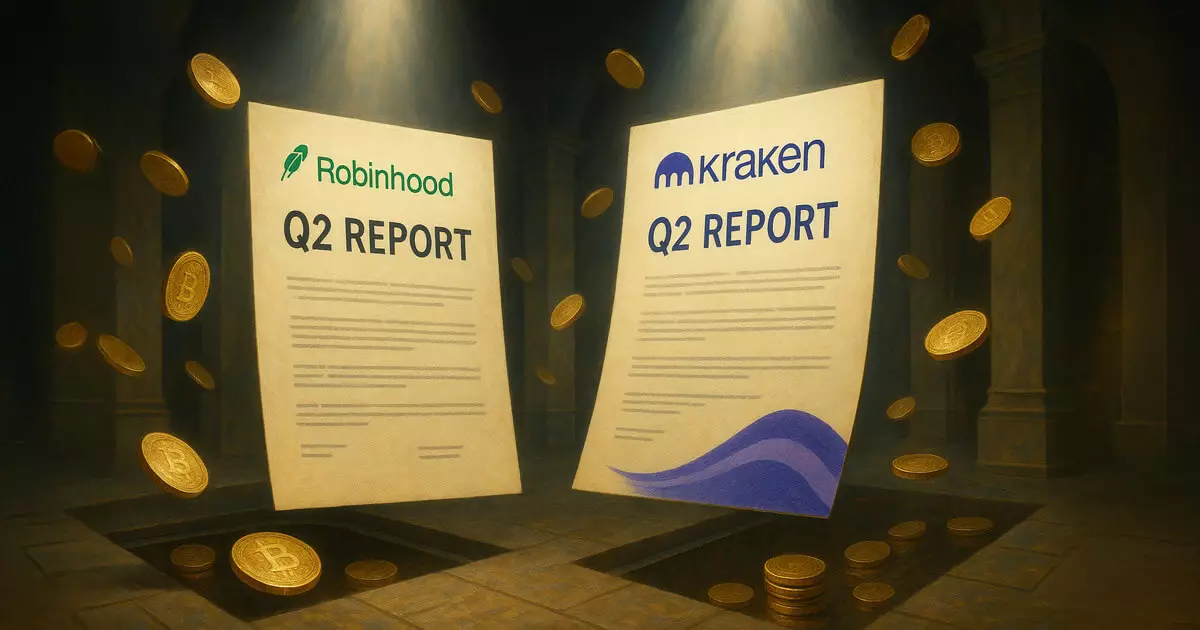While Robinhood and Kraken boast impressive year-over-year growth figures, a deeper, more critical analysis reveals underlying vulnerabilities that challenge the sustainability of their current trajectories. The apparent surge in crypto activity, revenue, and user engagement can be overshadowed by signs of strain in quarter-over-quarter results and broader market pressures. This discrepancy underscores a fundamental truth: the optimism expressed in these earnings reports may obscure a precarious market reality that requires cautious scrutiny rather than blind celebration.
In Robinhood’s case, the company’s 45% YoY revenue increase, predominantly fueled by a 98% YoY leap in crypto transaction revenue, appears to be a sign of strength. Yet, the 32% decline in crypto trading volume during the quarter signals a potential slowdown or correction gathering pace. Growth figures, often inflated by prior hype or temporary surges, mask the volatility intrinsic to the crypto space. Such rapid growth can sometimes be a mirage, driven by fleeting investor enthusiasm or speculative fervor rather than genuine, lasting adoption.
Kraken, despite its 18% YoY revenue boost, reflects this tension more starkly. A 13% QoQ revenue dip coupled with a decline in trading volume suggests the fragility of the quarterly bounce. Moreover, declining exchange volume might hint at investor fatigue or a shifting focus away from high-volume trading. While Kraken’s solid increase in user count and assets under management is commendable, it doesn’t necessarily guarantee long-term stability if these current trends do not reverse or stabilize.
The Illusion of Strength in Expansion and Innovation
Both platforms have actively pursued growth through diversification and innovative product offerings—Robinhood’s tokenized equities for European users and plans for Layer 2 protocols, and Kraken’s focus on stablecoin trading and European market expansion. These moves, on the surface, show strategic foresight and agility. Yet, from a critical perspective, they may also represent reactive measures to the market’s turbulent nature rather than proactive drivers of core stability.
Tokenized equities and Layer 2 Ethereum protocols sound impressive, but they are still relatively nascent. Their real-world utility, mainstream acceptance, and ability to generate sustainable revenues remain uncertain. The crypto market demands more than flashy tech launches; it requires consistent trust and user retention that can withstand market downturns. Relying heavily on innovative features during uncertain times may risk overstretching resources and diluting focus from essential, revenue-generating operations.
Kraken’s increased market share in stablecoin-to-fiat trading highlights a strategic pivot. But stablecoins are not immune to risks either—liquidity issues, regulatory crackdowns, and market shocks could erode their perceived safety and utility. While Kraken’s proof-of-reserve claims are reassuring, they are also anecdotal in a market where transparency and accountability are sometimes more aspirational than actual.
Regulatory Gains Do Not Equal Market Resilience
Another area worth criticism is the assumption that regulatory progress equates to market stability or legitimacy. Kraken’s licensing in Ireland and Canada might look positive, but in reality, regulation acts as a double-edged sword. Heavy compliance burdens might limit innovation, and new regulations could tighten constraints on crypto activities, especially if market volatility persists or worsens.
Furthermore, regulatory frameworks are still evolving in many jurisdictions, leaving platforms in uncertain legal waters. While Kraken’s compliance efforts are commendable, they do not shield the market from the broader macroeconomic and geopolitical forces that continue to threaten crypto’s nascency. Regulatory headlines can suddenly turn sour, wiping out gains and further shaking investor confidence.
The Broader Market Reality: Caution Must Prevail
The narrative painted by Robinhood and Kraken’s recent reports suggests resilience and bold expansion. But a more skeptical view sees this as a market still riding the wave of speculation, with fundamentals often secondary to hype and short-term gains. As other sectors of the economy face slowing growth and increasing scrutiny, the crypto market’s volatility remains an inherent obstacle—one that these firms are arguably ill-equipped to manage if optimistic projections falter.
In a landscape marked by rapid innovation and frequent regulatory shifts, true strength will be demonstrated not merely by impressive metrics, but by the ability to adapt, withstand downturns, and prioritize genuine utility over superficial growth. The current apparent boom may be a temporary phase—one that masks potential risks rather than mitigates them. Investors and industry observers should approach these headlines with a healthy dose of skepticism, recognizing that the illusion of strength in numbers can sometimes obscure deeper, more persistent vulnerabilities.

